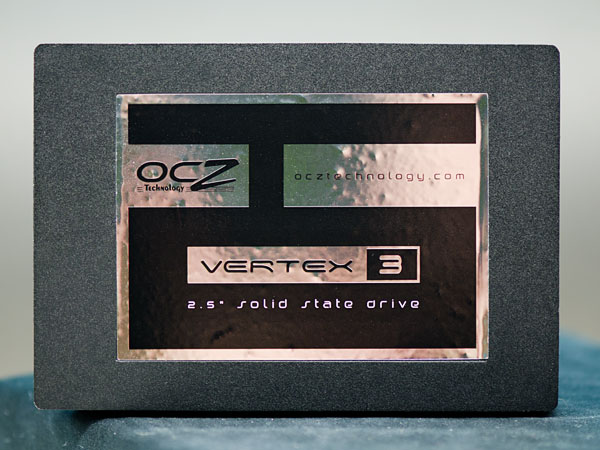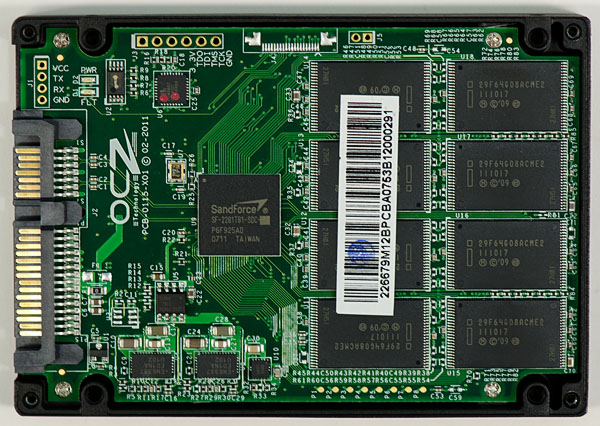The OCZ Vertex 3 Review (120GB)
by Anand Lal Shimpi on April 6, 2011 6:32 PM ESTThe Vertex 3 120GB
Whenever we review a new SSD many of you comment asking for performance of lower capacity drives. While we typically publish the specs for all of the drives in the lineup, we're usually only sampled a single capacity at launch. It's not usually the largest, but generally the second largest and definitely an indicator of the best performance you can expect to see from the family.
Just look at the reviews we've published this year alone:
Intel SSD 510 (240GB)
Intel SSD 320 (300GB)
Crucial m4 (256GB)
While we always request multiple capacities, it normally takes a little while for us to get those drives in.
When OCZ started manufacturing Vertex 3s for sale the first drives off of the line were 120GB, and thus the first shipping Vertex 3 we got our hands on was a more popular capacity. Sweet.
Let's first look at the expected performance differences between the 120GB Vertex 3 and the 240GB drive we previewed earlier this year:
| OCZ Vertex 3 Lineup | |||||
| Specs (6Gbps) | 120GB | 240GB | 480GB | ||
| Max Read | Up to 550MB/s | Up to 550MB/s | Up to 530MB/s | ||
| Max Write | Up to 500MB/s | Up to 520MB/s | Up to 450MB/s | ||
| 4KB Random Read | 20K IOPS | 40K IOPS | 50K IOPS | ||
| 4KB Random Write | 60K IOPS | 60K IOPS | 40K IOPS | ||
| MSRP | $249.99 | $499.99 | $1799.99 | ||
There's a slight drop in peak sequential performance and a big drop in random read speed. Remember our discussion of ratings from earlier? The Vertex 3 was of course rated before my recent conversations with OCZ, so we may not be getting the full picture here.
Inside the 120GB Vertex 3 are 16 Intel 25nm 64Gbit (8GB) NAND devices. Each device has a single 25nm 64Gbit die inside it, with the capacity of a single die reserved for RAISE in addition to the typical ~7% spare area.
The 240GB pre-production drive we previewed by comparison had twice as many 25nm die per package (2 x 64Gbit per NAND device vs. 1 x 64Gbit). If you read our SF-2000 launch article one of the major advantages of the SF-2000 controller has over its predecessor is the ability to activate twice as many NAND die at the same time. What does all of this mean for performance? We're about to find out.
RC or MP Firmware?
When the first SF-1500/1200 drives shipped last year they actually shipped with SandForce's release candidate (RC) firmware. Those who read initial coverage of the Corsair Force F100 drives learned that the hard way. Mass production (MP) firmware followed with bug fixes and threatened to change performance on some drives (the latter was resolved without anyone losing any performance thankfully).
Before we get to the Vertex 3 we have to talk a bit about how validation works with SandForce and its partners. Keep in mind that SandForce is still a pretty small company, so while it does a lot of testing and validation internally the company leans heavily on its partners to also shoulder the burden of validation. As a result drive/firmware validation is split among both SandForce and its partners. This approach allows SF drives to be validated heavier than if only one of the sides did all of the testing. While SandForce provides the original firmware, it's the partner's decision whether or not to ship drives based on how comfortable they feel with their validation. SandForce's validation suite includes both client and enterprise tests, which lengthens the validation time.
The shipping Vertex 3s are using RC firmware from SandForce, the MP label can't be assigned to anything that hasn't completely gone through SandForce's validation suite. However, SF assured me that there are no known issues that would preclude the Vertex 3 from being released today. From OCZ's perspective, the Vertex 3 is fully validated for client use (not enterprise). Some features (such as 0% over provisioning) aren't fully validated and thus are disabled in this release of the firmware. OCZ and SandForce both assure me that the SF-2200 has been through a much more strenuous validation process than anything before it.
Apparently the reason for OCZ missing the March launch timeframe for the Vertex 3 was a firmware bug that was discovered in validation that impacted 2011 MacBook Pro owners. Admittedly this has probably been the smoothest testing experience I've encountered with any newly launched SandForce drive, but there's still a lot of work to be done. Regardless of the performance results, if you want to be safe you'll want to wait before pulling the trigger on the Vertex 3. SandForce tells me that the only difference between RC and MP firmware this round is purely the amount of time spend in testing - there are no known issues for client drives. Even knowing that, these are still unproven drives - approach with caution.
The Test
| CPU |
Intel Core i7 965 running at 3.2GHz (Turbo & EIST Disabled) Intel Core i7 2600K running at 3.4GHz (Turbo & EIST Disabled) - for AT SB 2011, AS SSD & ATTO |
| Motherboard: |
Intel DX58SO (Intel X58) Intel H67 Motherboard |
| Chipset: |
Intel X58 + Marvell SATA 6Gbps PCIe Intel H67 |
| Chipset Drivers: |
Intel 9.1.1.1015 + Intel IMSM 8.9 Intel 9.1.1.1015 + Intel RST 10.2 |
| Memory: | Qimonda DDR3-1333 4 x 1GB (7-7-7-20) |
| Video Card: | eVGA GeForce GTX 285 |
| Video Drivers: | NVIDIA ForceWare 190.38 64-bit |
| Desktop Resolution: | 1920 x 1200 |
| OS: | Windows 7 x64 |












153 Comments
View All Comments
jjj - Wednesday, April 6, 2011 - link
any chance of a comparison soon for the new gen SSDs running on p67 vs the non native sata 3 controllers out there(the marvell controller on many 1366 and 1155 boards or/and some cheap PCIe sata3 cards) and maybe an AMD system too?A5 - Wednesday, April 6, 2011 - link
I think they did a comparison in the P67 article. The P67 controller is the fastest, followed by AMD (it's within a few %), and then the 3rd part controllers are a good bit slower.Movieman420 - Wednesday, April 6, 2011 - link
What more can I say? I've been chomping at the bit over this issue ever since SR broke the story. As a loong time Ocz customer (ok...fanboy..lol) I couldn't believe Ocz was behaving like that. The max speed rating using the fastest test available is excusable...like you said, if Ozc would have went the altruistic route then the competition would have take full advantage in about 1 millisecond. After finding out about the inevitable switch to 25nm I quickly ordered another drive for my existing array from a lesser known vendor that I hoped was still selling older stock. I received the drive and to my dismay it was a 25nm/64Gb piece. Adding this drive to my existing array of 34nm/32Gb drives would have a definite negative effect. Which brings me to my point."After a dose of public retribution OCZ agreed to allow end users to swap 25nm Vertex 2s for 34nm drives, they would simply have to pay the difference in cost. OCZ realized that was yet another mistake and eventually allowed the swap for free."
This is only partially true. Replacements were offered based on drives that formatted below IDEMA capacity. If your drive formatted to the correct size, you were not eligible to swap. The only problem is that the 64Gb dies were also used in Vertex 2/Agility 2 drives that feature 28 percent over-provisioning (i.e. 50, 100, 200gb models). In this case the decreased capacity was 'hidden' for lack of a better term. This is where I locked horns with them. The exchange was only offered for the 60'E' and 120'E' drives even tho many others suffered the same performance issue for the same reason. I had to raise a bit of hell before they agreed to replace my 64nm/64Gb 'non-E' drive with a 34nm replacement. At first they would only swap for another 25nm drive and I stated that my issue was with performance NOT die size. They ended up replacing my drive with a 34nm model only because it would have put a hurting on my existing raid array of 34nm drives...they made it clear that this was an exception since I had a raid array that would be negatively affected. So anyone who bought a 28 percent OP drive with 64Gb nand chips was DENIED any sort of exchange unless a raid array was involved. As far as I know, that policy still stands unless Ryan or Alex decides to make good on the exchange for 28 percent OP, non 'E' 64Gb die drives which are internally identical to the 'E' drives just with a different amount of OP set by the firmware. While I may have been 'lucky' if you will because I had an array involved, there's people out there that purchased a high OP model which if anything should be a slightly better performer and instead it's the complete opposite. Charge a premium for the more expensive NAND? Absolutely! Just don't offer a half hearted exchange that doesn't cover all models affected...and not just for the ones whose OP doesn't hide the issue.
CloudFire - Wednesday, April 6, 2011 - link
thanks anand! really glad you put some pressure on Ocz. I hope other companies will follow suite as well. Here's to hoping you'd continue to do the right thing for us consumers in the future! :DDennis.Huang - Wednesday, April 6, 2011 - link
Thank you for the review and for your actions on behalf of customers. This was a great review for me as a new person to SSDs. Do you have any thoughts of the performance of the 480GB version of the Vertex 3 and/or do you plan to do a review on that version too?kensiko - Thursday, April 7, 2011 - link
I saw some number on the OCZ forum, I think it came from Ryder, for the 480GB and it performs even better than the 240.kensiko - Thursday, April 7, 2011 - link
Here:IO METER (QD=1) 2008 on P67 SATAIII
120GB 240GB 480GB
4KB Random READ 16.31 15.58 17.77
4KB Random WRITE 14.45 14.97 15.99
128KB Seq. READ 190.23 255.17 355.89
128KB Seq WRITE 345.21 342.99 313.98
bennymankin - Wednesday, April 6, 2011 - link
Please include Vertex 2 120GB, as it is probably one of the most popular drives out there.Thank you.
kensiko - Thursday, April 7, 2011 - link
The F120 does it, but true it's not the 25nmShark321 - Friday, April 8, 2011 - link
I concur. Vertex 2 120 GB should be compared to Vertex 3 120GB. I suspect the differences will be minimal on SATA II. It's basically the same product, with slight controller and firmware changes.